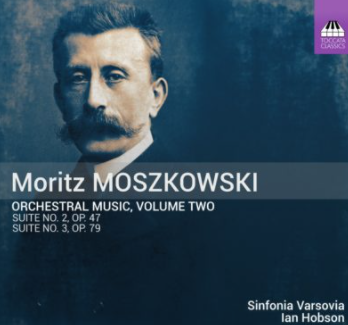CD Review: Moritz Moszkowski: Orchestral Music, Volume Two
Ian Hobson, conductor
Jakub Haufa, violin; Zuzanna Elster, harp; Damian Skowroński, organ
Sinfonia Varsovia
Toccata
Catalogue Number: TOCC0557
Ian Hobson can do anything. Here is an interesting parallel: music by a pianist renowned in his time, who wanted to be taken seriously as a composer of larger forms; conducted by a renowned pianist of our time, who is also a gifted orchestra leader.
We must thank Mr. Hobson for rescuing Moritz Moszkowski (1854-1925) from his reputation as a composer of glittery “salon-ish” music (think: Spanish Dances for piano duet, the 15 Etudes de virtuosité for piano, or Horowitz’s classic encore Etincelles), and for blowing some of the musical cobwebs off his diverse output. Some of Moszkowski’s story reads very sadly, as tastes and musical fashion seemed to move on without him. He turned to the United States for salvation, but had to be financially bailed out by sympathetic artists, only to die before receiving the benefits of the concert.
The two suites (Deuxième Suite d’Orchestre, Op. 47, Troisième Suite d’Orchestre, Op. 79) on this disc are not shy, little pieces. The Second Suite, composed in 1890 and given its premiere recording here, is forty-one minutes long. The Suite allowed the composer more structural freedom than a typical symphony, and Moszkowski pours it on, with six movements, including a Prelude, Fugue, Scherzo, Larghetto, Intermezzo, and March; a veritable mini-survey of orchestral variety.
The Sinfonia Varsovia plays beautifully under Mr. Hobson’s direction. The Prelude immediately draws one in with its brooding, yearning, rhapsodic string writing, only to stop on a half-cadence that ushers in a “celestial vision” quasi-cadenza for solo harp and violin. The brief sounds of the organ at the conclusion follow, the only truly Baroque reference, leading to the attacca Fugue, which is livelier in tempo, but with similar emotional darkness- its subject reminiscent of the head motif of Bach’s G minor fugue from the Well-Tempered Clavier, Vol. 1. The entries are easy to follow, thanks to Moszkowski’s transparent handling of a large orchestra. Every contrapuntal device is present- augmentation, stretto, a pizzicato section, and another Baroque reference with the reappearance of the organ. For me, the only miscue (sorry, Moritz!) is the triumphant but inconclusive Picardy third ending.
A lively Scherzo in G minor, with its distinctive motto, is easy for the listener to follow. A Larghetto fourth movement (B -flat Major), the emotional heart and longest movement of the Suite, is intense and passionate, and although some have compared it to Wagner, it is much more concise. An Intermezzo (D major) fills the function of the old minuet and trio from the classical symphony. The concluding March (G major) provides a suitably rousing ending; I found it, thankfully, more elegant than martial, a sort of spiritual descendant of Schumann.
The Third Suite is marginally better known, and at only just over half the length of the Second Suite, is a petite cousin, so to speak. Perhaps that stems from its provenance, just over seventeen years later, after Moszkowski settled in Paris. Even the instrumentation seems a bit more transparent. An opening Allegro has a distinctive horn motto, but doesn’t belabor it, preferring melodic sweep. The second movement, Molto moderato, has a wonderful subtitle: La note obstinée (The stubborn note), which in this case is a middle C, that begins and ends the piece in the horn and transfers to the harp part, around which the music moves in sometimes surprisingly remote keys. The third movement is a glorious salon-waltz, the sort for which we remember Moszkowski, perhaps unfairly. Fanfares announce the finale, which provides a satisfying conclusion.
I can imagine, in a post-pandemic world, orchestral subscription audiences pleasantly settling in to hear either or both of these suites. Moszkowski has indeed found a persuasive advocate in Mr. Hobson.

